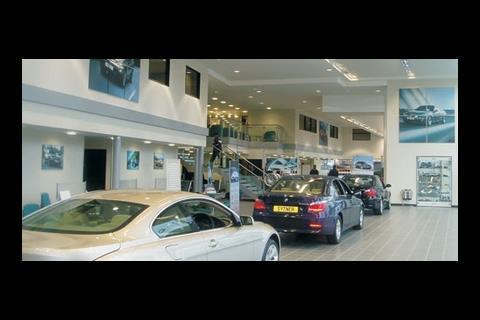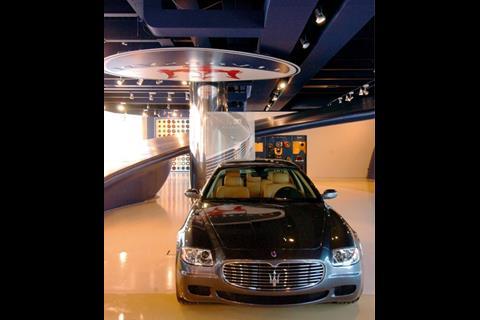Those temples to the automobile can be lavish enterprises, with double-height glazing, blazing lights and costly stone floors. And that’s before you even get into the realms of internet cafes and branded clothing. Maxwell Wilkes of Davis Langdon offers an unbeatable all-in price
01 Introduction
A car is one of the most expensive purchases a person makes and today’s showroom has an important role in helping customers make that decision.
In an increasingly segmented market, an outlet needs to cater for a range of clients and their needs.
In today’s brand-driven society, cars and lifestyle overlap and the sales environment should reflect the customer’s preferences.
The scope of a car dealership scheme is not limited to sales. After-sales service is an element of the business model so a service reception and a parts and workshop facility are often located on a showroom site.
At prestige outlets, customers may have access to refreshments, wireless or internet connections in coffee bars or lounges.
02 Design considerations
Car showrooms need to be located on highly visible sites with good access to main transport routes and an eye-catching frontage. Display of the car range is paramount and the layout and orientation of sites and display areas will have a major impact on sales.
These considerations affect environmental control strategies, as not all buildings can be oriented to mitigate solar gain and heavily tinted solar control glass is not generally considered for the main facade.
As part of the fit-out, additional space may be given over to financial services companies providing loans, insurance and similar products.
The current trend is for a double-height display area with the main frontage in full-height glazing, making a design statement and providing high visibility. Glazing over 3m high does not qualify as a shopfront, which means the solar gain component must be included in Part L calculations. Furthermore, double-glazed units must be specified, rather than the clear single-glazing typical of shopfronts.
The building services standard is also high. Comfort cooling in customer areas is required to control solar gains in highly glazed areas. Showroom lighting – which reinforces brand identity, displays cars in the best light and creates the right mood – is a useful sales tool.
Many materials used in showroom construction, including cement, steel frame, metal and glazed cladding and some building services components, have been subject to volatile price changes in the past two years, introducing added risk for developers and contractors.
A further area of uncertainty relates to the introduction of Part L in 2006. For most motor dealerships, sustainability is not a major business driver, but delivering buildings that meet manufacturers’ design codes could be a challenge. Although occupancy-related cooling loads are not a major issue, loads related to solar gain are.
Measures taken to mitigate loads, energy use and carbon emissions include:
- Use of extended eaves, brise-soleil and canopies to reduce solar gain, particularly on the main facade
- Use of rooflights to provide basic levels of illumination without adding to cooling loads
- Enhanced insulation for solid cladding and roofs
- Lighting control
- Offsetting relatively high carbon emissions in a mechanically cooled showroom across the total floor area of the scheme, which includes areas such as workshops with lower loads.
The European Block Exemption rules on franchises influence the manufacturer’s specification of finishes in such businesses. Finishes are typically of high quality,
often with a stone tile floor and wall lining system. The showroom may also have a balcony or gallery.
Corporate branding by manufacturers is leading to a trend for standardised fixtures, fittings and equipment specified to meet “corporate identity standards” that turn showrooms into bespoke retail boxes. The choice of materials, such as timber flooring in lieu of tiling, is another way for a manufacturer to reinforce its visual image.
With the value of the stock on display, security is a major concern. Showrooms have comprehensive access control, alarms and sophisticated CCTV. CCTV is located internally and externally and uses infrared for night-time vision. It may feature movement tracking and link back to remote monitoring centres. Some systems feature loudspeaker systems used by remote monitoring teams to warn intruders that they are on camera.
Discreet physical security measures such as forecourt bollards and perimeter fencing are also necessary to prevent unauthorised vehicle entry and exit, but must not interfere with customer views of vehicles on display.
The external works account for a considerable proportion of overall expenditure. Forecourt sales and parking for various repairs and servicing functions are the main cost drivers. The estimate must also factor in the costs of bypass separators and other effluent treatment solutions to minimise the risk of any pollutant run-off, as well as expenditure on branding, such as external lighting, flag posts and brand totems.
03 Funding and procurement
For most developers of car showrooms, design and build is the preferred procurement route.
It is ideally suited because the typical showroom is neither large nor complex. Employers’ requirements can be issued at a relatively late stage of design, as far as RIBA Stage E, and will incorporate prescriptive designs and specifications for completion by the contractor’s team.
Design and build offers clients that are not professional developers the opportunity to use a manufacturer’s pre-determined corporate specifications and finishes, while transferring design, commercial and construction risk to the contractor, obtaining cost certainty with a consistent quality finish.
For this, the client needs to use amended contracts that place responsibility for both the employers’ requirements and contractor’s proposals with the contractor.
Development of car showrooms can be undertaken by a number of parties. The options available are generally either freehold or sale and leaseback:
- Freehold: the financing of the showroom is undertaken by the dealership, which then keeps it as an investment. This is the traditional approach.
- Sale and leaseback: the dealership develops and then sells the showroom and associated assets to a financial institution, leasing it back for a specified period of time.
This enables the dealership to release the capital tied up in the development and concentrate on motor retail rather than on its property portfolio.
- The manufacturer: The opportunity to develop is sometimes determined by the manufacturer. Some support dealerships by providing information regarding preferred sites, and give potential sales expectations for the area. In some cases, manufacturers prefer to act as their own developer, acquiring and developing a site and then either renting it to the dealership or selling it into the investment market.
Showrooms are seen as secure investments, although most manufacturers offer franchises for five years rather than a typical building lease term of 15 years.
Dealerships obviously make strenuous efforts to retain appropriate franchises, maintaining their facilities to a high standard and usually upgrading the fit-out every five years alongside the renewal of the franchise.
04 New dealership trends
Changes to the European Block Exemption law, which governs how franchises are held and managed, has facilitated the growth in multi-franchising within a single dealership. These arrangements enable consumers to compare different manufacturer’s models on a single site.
The dealership tends to locate the franchises in either co-located or adjacent showrooms. This means the shell construction must be adaptable to the different specifications demanded by the manufacturers.
As a result, the size of some dealerships has increased up to a floor area of 3,000m2.
A scheme of this size will accommodate multiple franchises and extensive workshops, tyre bays and so on.
An alternative approach has been the use of boutique sites. These are small units positioned in city-centre retail sites or leisure developments. Matching the location, the customer profile and the correct brand of car are vital for success, off-setting high rental levels and development costs against the opportunity to target specific clients. These developments sometimes exploit the concept of coffee bars and branded clothing ranges found on larger sites.
Not content with just selling a car, warranty and road tax, manufacturers and dealerships are beginning to adopt the concept of “experiential retailing”. Land Rover has established an adventure zone next to Bluewater Park where customers can purchase branded clothing, off-road adventure holidays and “off-road experiences”.
05 Planning
It can be difficult to obtain planning permission for car dealerships. The Planning Portal guidance rulings often lead to the development of clusters of showrooms. The main concerns when applying for planning are:
- Traffic movement. This peaks at the start and end of the day, as vehicles are dropped off for servicing and delivery
- Location. The need to be highly visible on major transport routes or close to town may mean the proposed site is not in the correct local planning zones
- The desire for the forecourts to be illuminated for as long as possible, especially relevant in suburban locations
- Adequate drainage facilities with the need for a trade effluent licence, interceptors and treating waste products off site.
06 Cost model
The cost model is based on a multi-franchise dealership at the higher end of the market.
It comprises a new building subdivided into two double-height franchise display showrooms of 400m2 each, with additional office and ancillary space giving a gross internal floor area of 1,340m2.
The development is built on a brownfield site, which has previously been cleared.
The building has a reinforced in-situ concrete ground-bearing slab, a steel frame with reinforced concrete pads, a full-height glazed front, aluminium cladding on the side walls and aluminium standing seam roofing. Each showroom has separate entrance doors for customers and vehicles.
There is full comfort cooling in all areas and the cost of fitting out this and the display lighting is included. The external works consist of car parking, forecourt display area, landscaping and drainage.
The unit rates are derived from competitive design-and-build tenders and are current at the first quarter of 2007, based on a South-east location. The building-only cost is £1,221/m2.
The cost excludes franchise specified work, enabling works, demolitions, professional fees and VAT. Design fees are typically in the region of 12%.
Unit rates should be adjusted for the location, site conditions, programme and procurement route.
07 Acknowledgments
We would like to thank Davis Langdon’s Motor Retail group for their advice in the preparation of this cost model
Downloads
Cost breakdown
Other, Size 0 kb


























1 Readers' comment